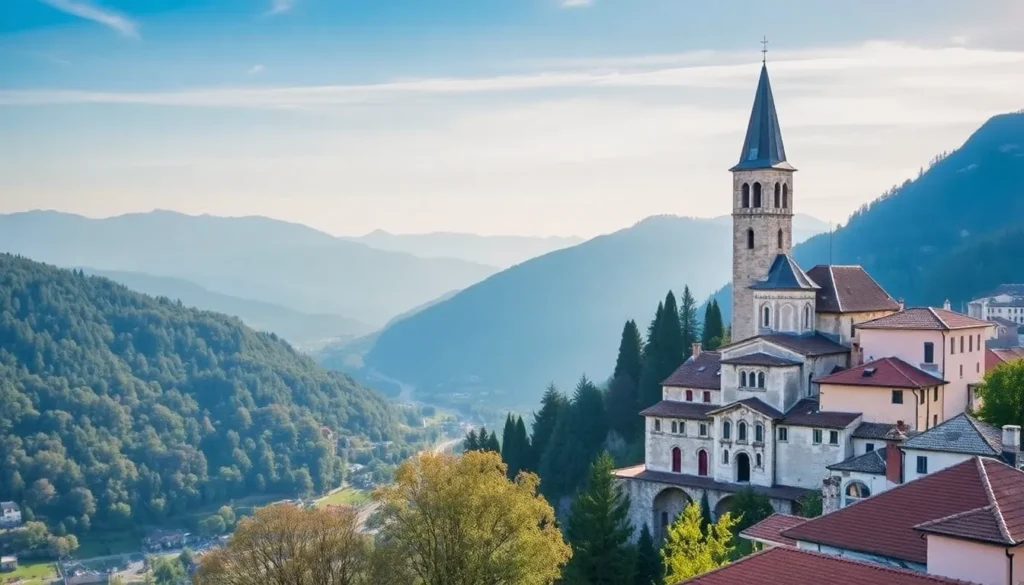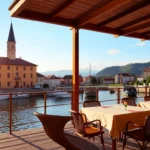Travel Tips for Friuli Venezia Giulia to Avoid Mistakes

- How to get to Friuli Venezia Giulia
- The best time to visit Friuli Venezia Giulia
- What to see in Friuli Venezia Giulia
- How many days are needed to explore Friuli Venezia Giulia?
- Getting around Friuli Venezia Giulia
- Where to stay
- What to eat in Friuli Venezia Giulia
- More tips for traveling to Friuli Venezia Giulia
Are you looking for the best tips to travel to Friuli Venezia Giulia? You’ve come to the right place! As a proud native of Friuli, I can share a wealth of firsthand recommendations. From must-visit places to the best areas to base yourself, detailed itineraries, and essential information for planning your trip, we’ll explore my beloved region together. Let’s dive in!
Friuli Venezia Giulia (or Friuli Venecia Julia in Spanish) may still be a relatively unknown region to many, even within Italy. However, those who visit are often left in awe, and it’s easy to see why. This region has it all: stunning beaches, rolling hills, majestic mountains, vineyards, charming villages, historic cities, rich culture, thermal baths, rivers, and lakes—everything you could possibly desire!
To make the most of your visit, it’s crucial to plan your trip carefully. Questions arise: How do you get there? Is renting a car worth it? What are the must-see stops? And what local dishes should you try? Don’t worry! After countless trips to the region, I’ve gathered all the information you need to plan the ultimate trip to Friuli Venezia Giulia. Ready to take notes?
How to get to Friuli Venezia Giulia
The most convenient way to reach Friuli from abroad is by flying into the Ronchi dei Legionari Airport, located near Trieste. Recently, Ryanair has launched a new route from Barcelona to Trieste, and we couldn’t be more excited!
If there are no flights from your city to Trieste, consider alternative airports like Treviso or Venice Marco Polo. I often fly to Bologna when returning home, as it offers more international routes. From Bologna, a direct train takes about two hours to reach Udine.
→ Compare and find the best flight deals on Skyscanner
If you’re traveling within Italy, you can take one of the trains that arrive in Udine or Trieste (check out Trenitalia for schedules) to start your journey through the region. Alternatively, you can use bus services like FlixBus.
→ Get €10 off when you book your transport across Italy and Europe through Omio
The best time to visit Friuli Venezia Giulia
One of the most prominent colors in Friuli is green. As they say in Asturias, the price for such beauty is continuous rain. Indeed, my beloved region experiences quite a bit of rainfall throughout the year, but there are moments when the skies offer a reprieve, especially during the summer. So, if you want to enjoy hiking in the mountains (even if you risk getting caught in a downpour) and sunny beach days, summer months are your best bet.
But is summer our favorite season? Not really. We often prefer to brave the rain and enjoy the vibrant colors of spring and autumn, when nature showcases its most explosive beauty and the temperatures are milder.
And what about winter? If you love to strap on your skis and glide over the snow, you’re in luck: Friuli Venezia Giulia boasts numerous ski resorts, making it a paradise for snow sports enthusiasts!
To sum it up: any time is perfect for a trip to Friuli Venezia Giulia, and each season has its pros and cons! Here are some annual climate charts from various cities in Friuli to give you a better idea:
What to see in Friuli Venezia Giulia
This small region in northern Italy, bounded by the Alps and the Dolomites to the north and the Adriatic Sea to the south, is dotted with charming villages and vineyards. It offers everything from sandy beaches to rocky coves, rivers, and lakes perfect for refreshing swims, vibrant cities filled with art, rural villages, hills, mountains, great food, trekking, and breathtaking waterfalls. Truly, it's a complete travel experience. As a proud Friulana, I can assure you!
Here’s our top 10 must-see places:
- Trieste: A city with Austrian influences and literary cafés.
- Grado: A blend of well-preserved historical center, tranquil beaches, and marine thermal baths.
- Aquileia: Home to the largest, oldest, and best-preserved early Christian mosaics in the region.
- Lignano Sabbiadoro: A popular beach destination among Italians and Europeans alike.
- Udine: A small capital with surprising attractions.
- Sauris: One of the most charming villages in Friuli, surrounded by breathtaking landscapes.
- Fusine Lakes: The perfect getaway to immerse yourself in nature.
- Fontanone di Goriuda: An 80-meter waterfall hiding a visitable cave, one of the region's hidden gems.
- Cividale: Visit the photogenic Devil's Bridge and the Lombard Temple, unique in its category.
- Collio: Essential for experiencing Friuli’s wine culture and sampling its exquisite wines.
⭐ For more details, check out our article on the best things to see and do in Friuli Venezia Giulia.
How many days are needed to explore Friuli Venezia Giulia?
This is a highly customizable point, as it depends on your travel pace, priorities (whether you prefer mountains or beaches), and the places you want to include in your itinerary. Even just spending a day in Trieste makes the flight worthwhile. However, if you can gather several days for an epic journey, that would be even better.
Our last four-day road trip allowed us to cover the essentials of the region. However, if you want to thoroughly explore each area and enjoy all its charms, we suggest you plan for at least one week. This way, you can have a super complete trip that includes relaxing beach days, hiking adventures, and cultural visits.
I always say that once you visit Friuli Venezia Giulia, you’ll want to come back; this region captivates you, and you’ll have no choice but to return.
Getting around Friuli Venezia Giulia
While the public transport network is quite extensive and reliable, renting a car is the best option to explore Friuli Venezia Giulia at your own pace. This way, you’ll have complete control over your time and won’t have to play Tetris with bus schedules and routes. Additionally, buses cover major tourist destinations but won’t take you to the more remote spots that are definitely worth visiting.
If you decide to rent a car, rest assured that the roads are in excellent condition, both on major routes and the local roads connecting mountain villages.
⭐ Take note of this four-day itinerary in Friuli Venezia Giulia.
Regarding tolls, as you may know, toll highways (autostrade) are common in Italy, marked with green signs. However, in Friuli, there aren't many toll roads (the route to Trieste via the A4 and the one leading to Tarvisio via the A23), so you can easily opt for free alternatives.
We always use Google Maps to calculate routes, as it allows you to avoid tolls. Be sure to review the route before you start, as it sometimes gives odd suggestions.
Lastly, it’s important to know that during peak season, there are some popular areas where a fee is charged for entering with a car (for example, at the Fusine Lakes). In other places, like cities or towns, you'll have to pay for blue zone parking.
⭐ Here, you can find out how to rent a car and drive in Italy.
Where to stay
Finding the best base depends largely on your planned route. My situation is a bit unique, as my parents live in Fagagna, in the central part of the region. So whenever we visit, we combine a few days there with time spent in other areas. It’s a great idea, especially in charming villages like San Daniele or even the city of Udine.
However, our advice for a trip to Friuli is to consider changing accommodations based on your itinerary to maximize your time. For a four-day trip like ours, you could stay two nights at a seaside location (Lignano or Grado) and spend two nights in the mountains (Sappada, Sauris, Arta Terme, Tarvisio, etc.), finishing your stay in Trieste.
If it fits into your route, check out the Grand Hotel Gortani in the Arta Terme area, which features a year-round heated outdoor pool, sauna, and Turkish bath for all guests. Highly recommended and reasonably priced!
→ We always book in advance through Booking with free cancellation options.
What to eat in Friuli Venezia Giulia
Get ready for a culinary delight: Friuli Venezia Giulia is a crossroads region (it borders Austria to the north and Slovenia to the east), so you’ll find influences from both countries, along with the delicious foundations of Italian cuisine and several local recipes full of character.
We’ve prepared a post about typical dishes to try in Friuli Venezia Giulia, but here’s a sneak peek of our top three favorites:
- Frico: The most beloved Friulian dish, it’s a kind of tortilla made in a pan with potatoes and cheese. Incredible!
- Prosciutto di San Daniele: The most famous Friulian product, this cured ham is sweet and mild in flavor. It even has its own festival: Aria di Festa (held annually in late June).
- Cjarsons: One of my all-time favorite bites, these are ravioli (more similar to pierogi than tortellini) filled with a variety of ingredients (potatoes and herbs, ricotta, jam, chocolate…).
Without a doubt, one of the best tips for traveling to Friuli Venezia Giulia is to explore its gastronomy without hesitation!
More tips for traveling to Friuli Venezia Giulia
Before you go, don’t forget to check out these last tips for planning your trip to Friuli in the best possible way:
- Due to its location, it’s a great idea to plan a combined trip to Friuli Venezia Giulia, including Slovenia, Austria, or the Dolomites. However, as you’ve seen, this still-unknown region offers everything a traveler could desire.
- If you don’t have many days, ask yourself whether you prefer beach or mountain. Friuli has options for everyone, and you might want to dedicate some days to discovering the Adriatic beaches or hiking paths in the Dolomites and Julian Alps. We tend to lean toward the latter 😉
- In Friuli, they speak Friulian, which is much more than a dialect: it’s one of Italy’s three official languages (along with Italian and Sardinian). To say hello, you say mandi 😉
- If you travel at the end of June, you can attend Aria di Festa in San Daniele, a festival celebrating the ham (prosciutto di San Daniele). Another popular festival takes place in Carpacco in August, celebrating the frico, the most famous Friulian dish. Generally, from May to October, each village hosts its own festival, known as a sagra.
- This area witnessed significant battles during the World Wars. Today, you can find ruins, museums, memorials, and even cemeteries honoring those who fell, like the Redipuglia Memorial. We recommend reading a bit about the history of Friuli to better understand many of its emblematic places.
And that wraps up our tips for traveling to Friuli Venezia Giulia and enjoying my homeland to the fullest. We hope our travel guide to Friuli helps you plan your adventure, and if you have any questions, we are here to help!
A quick summary of ways to save on your trip:
| Save on your trip |
| Compare and find cheap flights here |
| Find accommodation at the best prices here |
| Book activities and excursions in Spanish here |
| Get a 5% discount on your travel insurance with IATI here |
| Reserve airport transfers here |
| Get a gift of €10 when booking transport across Europe here |
| Learn how to withdraw cash without fees here |
| 5% discount on your eSIM from Holafly here |
| Rent a car with the best deals here |
| Compare prices for van rentals here |
| The best travel books and guides here |
| All our articles about Italy |



Deja una respuesta